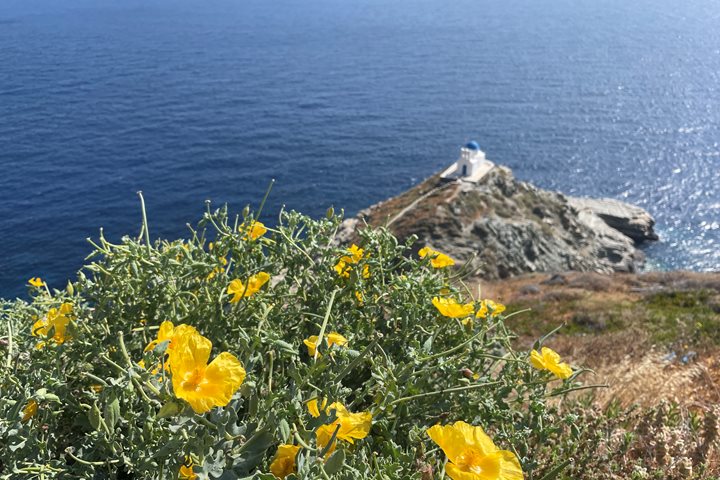Santorini (Ancient Thera), Greece
Sea Cloud continued her southerly course throughout the night, making her way to our morning destination of the island of Santorini. This marks the most southern end of our journey in the waters of the Mediterranean Sea, and the most southern island in the Cyclades. Santorini is actually a circular archipelago of several islands; the largest is the crescent-shaped island called Santorini, then a circle made up of Thirassia, Nea Kameni, Palia Kameni and Aspro Nisi completes the circle with an enormous and very deep caldera in the center. This archipelago formed after one of the most legendary volcanic explosions in Mediterranean history. This cataclysmic event occurred in approximately 1640 BC and buried a sophisticated Minoan community based in the village of Akrotiri located at the southern end of the island now known as Santorini.
The caldera is 76-square kilometers and the Sea Cloud entered the northwest entrance just after 7:00 a.m. this morning, continuing a slow cruise inside the caldera until it was time to move into position to tie up to mooring buoys just underneath the main town of Firá, perched 300 meters above on top of the steep walls of the caldera.
A local tender arrived promptly at 8:15.a.m. and ferried our group the short distance to the port town of Athinios where two busses awaited our arrival. Once onboard, our Greek guides Effie and Gemma began a narrative, painting a delicate, and expertly told story of Santorini and its history. Our busses were taking us from the only port where large vehicles can approach incoming ship traffic, up a series of switch-backs and then north along the backbone of the island’s volcanic ridge, to the northern tip of the island and one of the most famous and most photographed villages in the Mediterranean. Our morning stop was in the town of Oia, where the caldera cliff has been transformed by the building of extremely narrow cave houses, painted mostly white, though many other lovely bright colors have been added to the customary white buildings...and of course the ubiquitous blue-domed Greek Orthodox churches were in abundance!
Meeting times were arranged, a short tour was offered to get acquainted with the town of Oia and then we were all encouraged to lose ourselves in the small alleys and terraces, searching for just the right set of colors, blue sky, blue domes, blue sea, occasional windmill, and many, many hanging arrangements of bougainvillea around every corner. The morning light was lovely, the crowds dwindled to small and it was as though our perfect timing only helped each of usl acquire a lovely image with our cameras and/or a lovely image for our memories of this most famous Cycladic island.
All too soon, it was time to return to our waiting busses and make another tour of Santorini, this time closer to the sea and through the agricultural area of the island...past blooming wild Greek thyme, blooming caper plants and blooming bindweed, not to mention many a small garden filled with squash blossoms and maturing cherry tomato plants. Our lunch destination was the Kallisti Restaurant in the small village of Pirgos, located just under Santorini’s highest mountain peak. Once inside the restaurant, we enjoyed a very traditional Greek meal of mezedes, or small plates consisting of many of the specialties of Greece and some dishes known just on Santorini. Excellent local wine was served during lunch and for those with a yen for a truly traditional end to a meal in a small Greek village, a cup of Greek coffee provided a lovely finish. After lunch our busses took us to the principal town of Santorini, Thira (also “Fira”), to visit the archaeology museum and/or spend just a little more time wandering the narrow streets before making our way down to the port by either cable car or on the back of local donkey.
Back on board, the ship had made ready another opportunity to swim, this time very unique as we would all be swimming inside a volcanic caldera! It had been hot, dusty and in Fira, slightly crowded; jumping into the lovely waters of the Mediterranean was an inviting and refreshing way to complete our day.
The Sea Cloud remained at anchor just off of Palia Kameni well into the evening...walking the decks in the evening we could watch the light changing on the cliffs of the caldera; the sun reaching up the steep slopes as the sun slowly sank into the sea.






